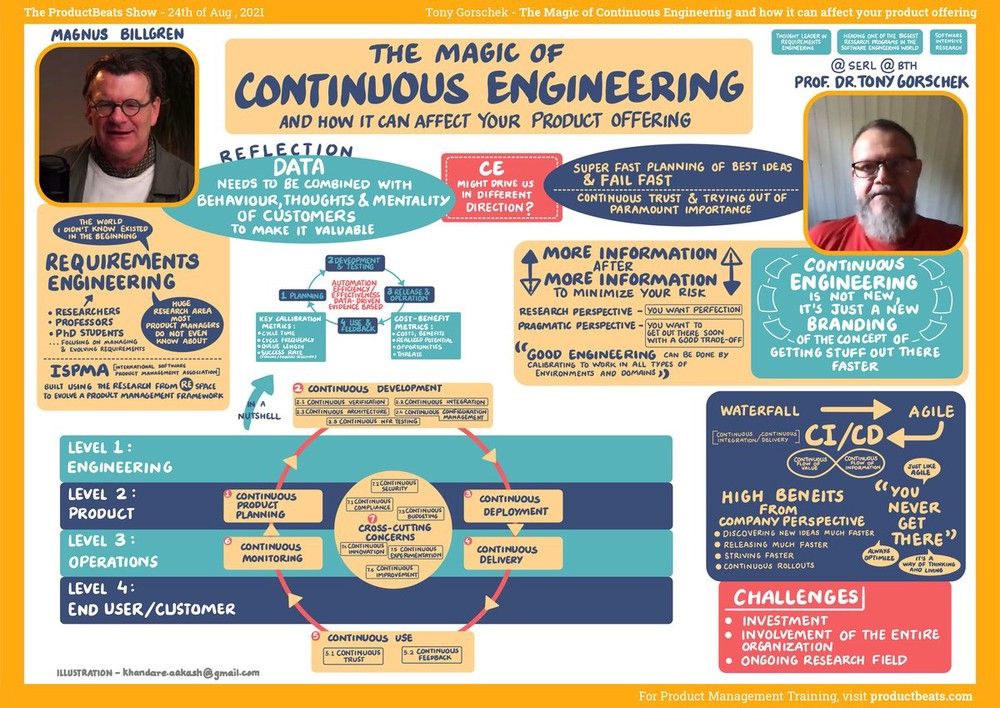Episode 70: Continuous Engineering w/Tony Gorschek
24 August, 2021 / Host: MAGNUS BILLGREN
Transforming Product Management in the Era of Rapid Development
In the fast-paced world of software engineering and product management, staying ahead of the curve is crucial for success. The emergence of continuous engineering has revolutionized the way organizations approach product development and management. In this episode of The Productbeats Show, Professor Dr. Dr. Tony Gorschek from BTH, a leading figure in the field of requirements engineering, shares insights into the transformative power of continuous engineering. From redefining the role of product managers to leveraging customer analysis, Professor Tony highlights the key aspects and benefits of continuous engineering in today's ever-evolving landscape.
The Rise of Continuous Engineering
Continuous engineering represents a paradigm shift in product management and development. By adopting a continuous thinking approach, organizations can optimize their processes and deliver value to customers more rapidly. Rather than the traditional linear waterfall model, continuous engineering enables a dynamic and iterative product development cycle, fostering collaboration between product managers, development teams, and customers. The philosophy of continuous engineering centers around constantly delivering value and obtaining timely feedback for informed decision-making.
Embracing the Product Team Model
With the advent of continuous engineering, the role of the product manager has undergone a significant transformation. Moving away from the individual-centric approach, product management now thrives on the collective effort of cross-functional product teams. This shift allows for a more holistic understanding of customer needs and enables a seamless integration of insights into the development process. By working closely with development teams and leveraging customer analysis, product managers can ensure the alignment of product vision, development efforts, and customer expectations.
The Continuous Planning-Delivery-Feedback Cycle
At the core of continuous engineering lies the continuous planning-delivery-feedback cycle. This iterative process encompasses four stages: planning, development, testing, and release. Each stage interconnects with the others, forming a cohesive and continuous flow of value. Automation plays a vital role in streamlining development tasks, but human expertise and decision-making remain essential in the planning phase. Product managers need to leverage automation for data collection and analysis to gain deep insights into customer behavior and preferences. This enables informed decision-making and the ability to adapt and iterate quickly based on feedback.
Benefits and Challenges of Continuous Engineering
Continuous engineering offers numerous benefits, including accelerated time-to-market, decreased roadmap uncertainty, and enhanced discovery of new ideas. By releasing products and features faster, organizations can gather rich customer feedback and iterate rapidly, enabling them to fail fast and refine their offerings based on real-world usage. However, challenges exist, such as the need for organizational alignment and investment in automation. Continuous engineering requires a cultural shift and a collaborative mindset across the entire organization to realize its full potential.
The Future of Continuous Engineering
As the field of continuous engineering continues to evolve, researchers and practitioners are working on addressing key areas such as deep analysis of customer data and the integration of user behavior into decision-making processes. The focus lies on understanding the cost-benefit trade-offs, evaluating the relevance of continuous engineering in different domains, and ensuring compliance and security in the face of rapid development. The future of continuous engineering holds promise for further advancements in data analytics, automation, and evidence-based decision-making.
Takeaways
- Continuous engineering is revolutionizing product management by enabling faster product development and streamlined processes.
- The adoption of continuous thinking and agile methodologies in product management leads to valuable customer feedback and improved customer satisfaction.
- Continuous engineering requires organizations to rethink their organizational structures and embrace digital transformation to fully leverage its benefits.
To unlock the full potential of continuous engineering and agile methodologies in product management, professionals are increasingly seeking comprehensive training and certification programs. One such program that stands out is The Productbeats Product Management Certification Program. This industry-leading program equips product managers with the skills and knowledge they need to excel in today's dynamic business environment. Whether you're a seasoned product manager looking to stay updated or a newcomer eager to enter the field, The Productbeats Product Management Certification Program offers a structured and immersive learning experience. Delve into the program's key features and see how it can accelerate your career growth in product management.
You might also enjoy watching...
Copyright © 2023 ProductBeats AB

Get The Program Brochure
Submit the form below to have The Program Brochure delivered to your inbox
The title of the notification
The descriptive text of the notification


